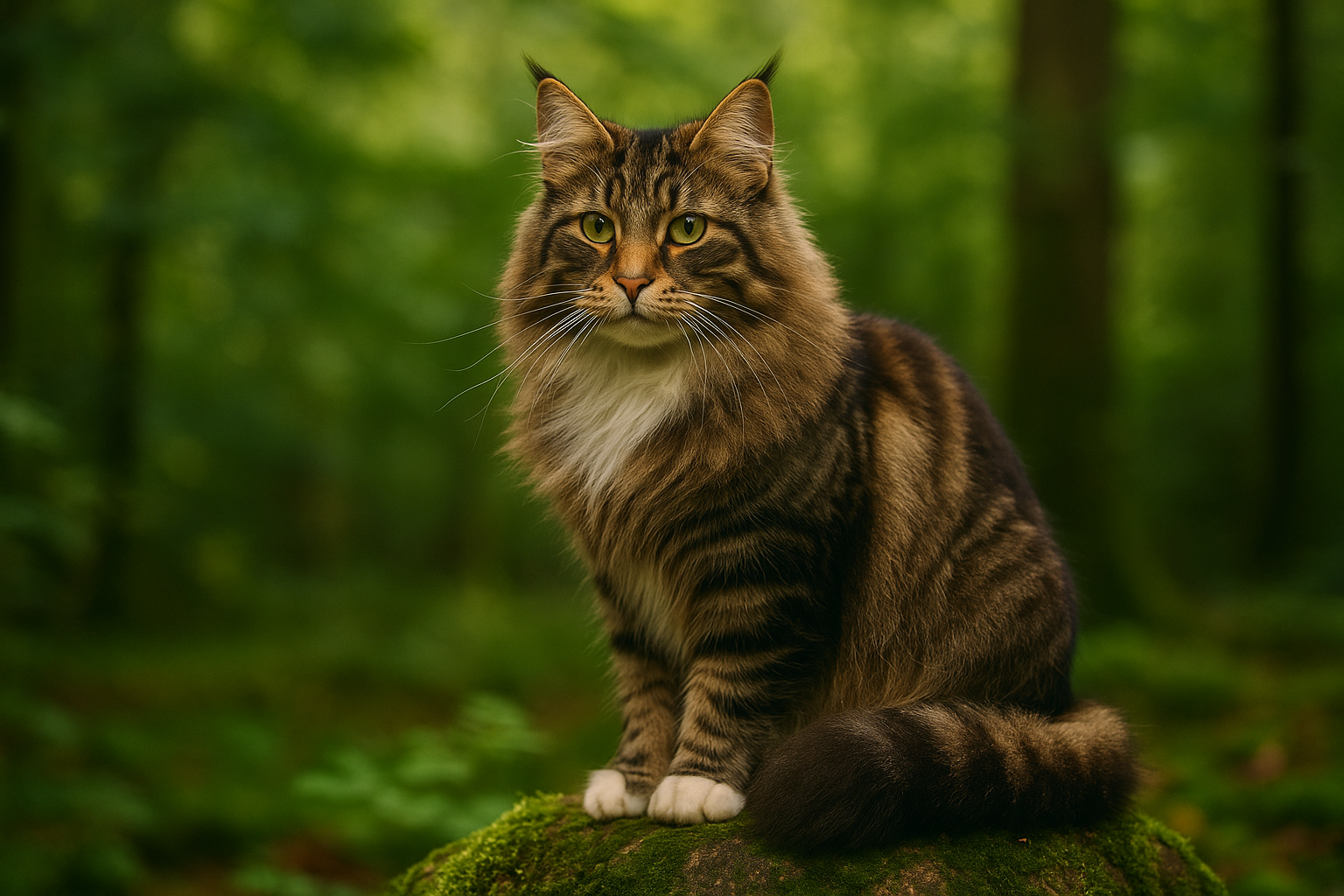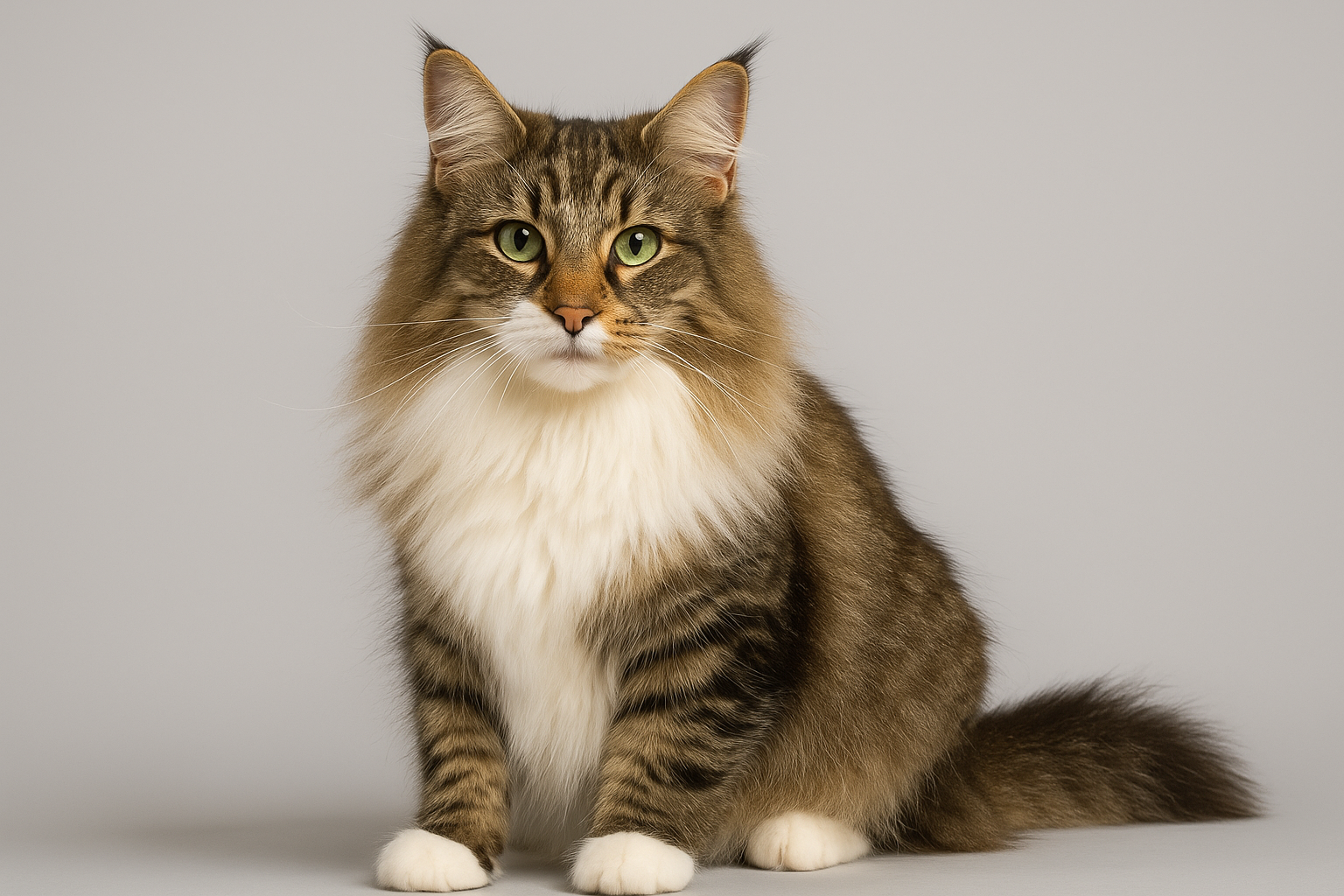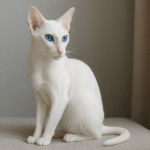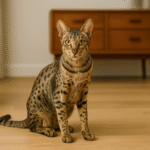If you dream of a big, fluffy cat that looks like it stepped out of a Norse legend, the Norwegian Forest Cat may be your perfect match. Known as the Wegie to fans, this ancient Scandinavian cat breed combines rugged good looks with a sweet, easygoing personality.
With roots stretching back to Viking times, this breed survived Norway’s forests and cold winters for centuries. Today, the Wegie is better known as a gentle companion with a majestic look—one that turns heads whether lounging on a windowsill or climbing a cat tree.
Quick Breed Facts
- Origin: Norway
- Breed registries: CFA, TICA, FIFe
- Weight range: Males 12–20 lbs, Females 9–16 lbs
- Lifespan: 14–16 years
- Coat: Long, thick, water-resistant double coat
- Colors and patterns: All colors and patterns except colorpoint
- Eye color: Green, gold, copper
- Grooming: Weekly brushing (more in shedding season)
- Activity level: Moderate to high
- Affection level: Moderate
- Vocality: Low
- Good with children: Yes
- Good with other pets: Yes
History & Origin
The Norwegian Forest Cat, or Skogkatt (“forest cat”), is one of the oldest natural cat breeds. For centuries, these hardy cats roamed Norway’s forests and farms, keeping rodents at bay and living alongside people. Legend even ties them to the goddess Freya, whose chariot was said to be pulled by giant cats.
The breed almost disappeared during World War II but was revived by Norwegian breeders in the 1970s. It was recognized by the FIFe in 1977, the CFA in 1993, and TICA soon after. Today, the Wegie is Norway’s national cat and a beloved companion worldwide.
Personality & Temperament
Norwegian Forest Cats are calm, friendly, and confident. They enjoy being near their people and will often follow you from room to room, but they’re not clingy. They’re often called “gentle giants” for their sweet nature and impressive size.
This breed is social and usually gets along well with children and other pets. They’re polite communicators and often use soft chirps or meows rather than loud calls.
Appearance
Norwegian Forest Cats have a striking, wild look. Their bodies are long and muscular, with strong bones and a bushy, flowing tail. They have a triangular head, large almond-shaped eyes, and upright ears that often sport lynx tips.
Their double-layered coat is dense and water-resistant—perfect for surviving the cold Scandinavian winters. Males are noticeably larger than females and may take up to five years to fully mature.

Activity & Play
Wegies are playful, smart, and love vertical spaces. They enjoy climbing, exploring, and perching up high. If you give them a tall cat tree or window perch, they’ll happily spend hours watching the world go by.
They aren’t hyper, but daily play helps keep them fit and mentally stimulated. Puzzle toys, wand games, and climbing shelves let them burn off energy and show off their natural hunting skills.
Grooming & Care
Even though their coats are long, Norwegian Forest Cats don’t mat as easily as some other longhaired breeds. Their semi-waterproof double coat benefits from brushing a couple of times a week.
During spring and fall, they shed much more than usual—you may find tufts of fur around the house. Regular brushing during this time helps keep loose fur under control and reduces hairballs.
Health & Lifespan
The Norwegian Forest Cat lifespan typically ranges from 14 to 16 years with proper care. As a natural breed, they’re generally healthy, but they are predisposed to a few conditions:
- Hypertrophic Cardiomyopathy (HCM): A heart condition seen in large breeds.
- Glycogen Storage Disease IV: A rare inherited disorder affecting metabolism.
- Hip Dysplasia: Can affect mobility in older or overweight cats.
Routine checkups, weight management, and good nutrition are essential to support your Wegie’s health and life expectancy.
Family Compatibility
Norwegian Forest Cats are wonderfully adaptable and make fantastic additions to households with kids, dogs, or other cats. They’re confident but not aggressive, and they often enjoy the company of well-behaved children and friendly dogs.
Because they’re not overly clingy, they work well for families or individuals who want an affectionate but independent companion. If they’re raised around people and other pets, they usually do great in all kinds of homes.
Recommended Supplies
As a large, longhaired cat with lots of energy, the Norwegian Forest Cat thrives with the right gear. Look for:
- High-protein, balanced cat food to support muscle and coat health
- A large, covered litter box to fit their size
- Brushes designed for longhaired cats
- Multi-level cat trees and sturdy scratching posts
Food with plenty of protein helps them stay strong and keeps their thick coat healthy. And since they love climbing, a heavy, wobble-free cat tree is a must-have for this breed.
Norwegian Forest Cat FAQs
Are Norwegian Forest Cats hypoallergenic?
No, Norwegian Forest Cats are not considered hypoallergenic. They produce normal levels of the Fel d 1 protein, which is the main allergen for humans.
How big do Norwegian Forest Cats get?
Adult males typically weigh between 12–20 lbs, while females range from 9–16 lbs. They are considered a large cat breed with strong, muscular builds and bushy tails.
What is the difference between a Norwegian Forest Cat and a Maine Coon?
Both are large, fluffy breeds, but Maine Coons often have a more rectangular body and lynx-like ear tufts, while Norwegian Forest Cats have a triangular face and straight profile. Wegies also have a slightly shorter muzzle and more almond-shaped eyes.
How is the Norwegian Forest Cat different from a Siberian Cat?
While both are natural forest breeds with long coats, the Norwegian Forest Cat typically has a straighter profile, more angular head, and bushier tail. Siberians are slightly more rounded and stockier with a thicker neck. Both are cold-climate cats but come from different parts of the world—Norway vs Russia.
Is the Norwegian Forest Cat bigger than a normal cat?
Yes, the Norwegian Forest Cat size is notably larger than the average domestic cat. Males can weigh up to 20 lbs, making them one of the larger domestic cat breeds.
How long do Norwegian Forest Cats live?
On average, 14 to 16 years—though with good care, many live even longer. Regular vet visits, a nutritious diet, and lots of love go a long way.
What does a Norwegian Forest Cat cost?
The Norwegian Forest Cat price ranges from $600 to $1,200 from a reputable breeder, depending on lineage, health screening, and region. Adoption through rescue groups is typically less expensive.
Is the Norwegian Forest Cat Right for You?
If you’re looking for a fluffy, friendly, and active cat with deep historical roots and a go-with-the-flow personality, the Norwegian Forest Cat is an excellent choice. They’re ideal for families, multi-pet households, or anyone who wants a majestic, low-drama companion that loves both play and quiet time.
Just be ready for a little extra grooming and lots of admiration from friends who can’t get over how beautiful your “Viking cat” is!







